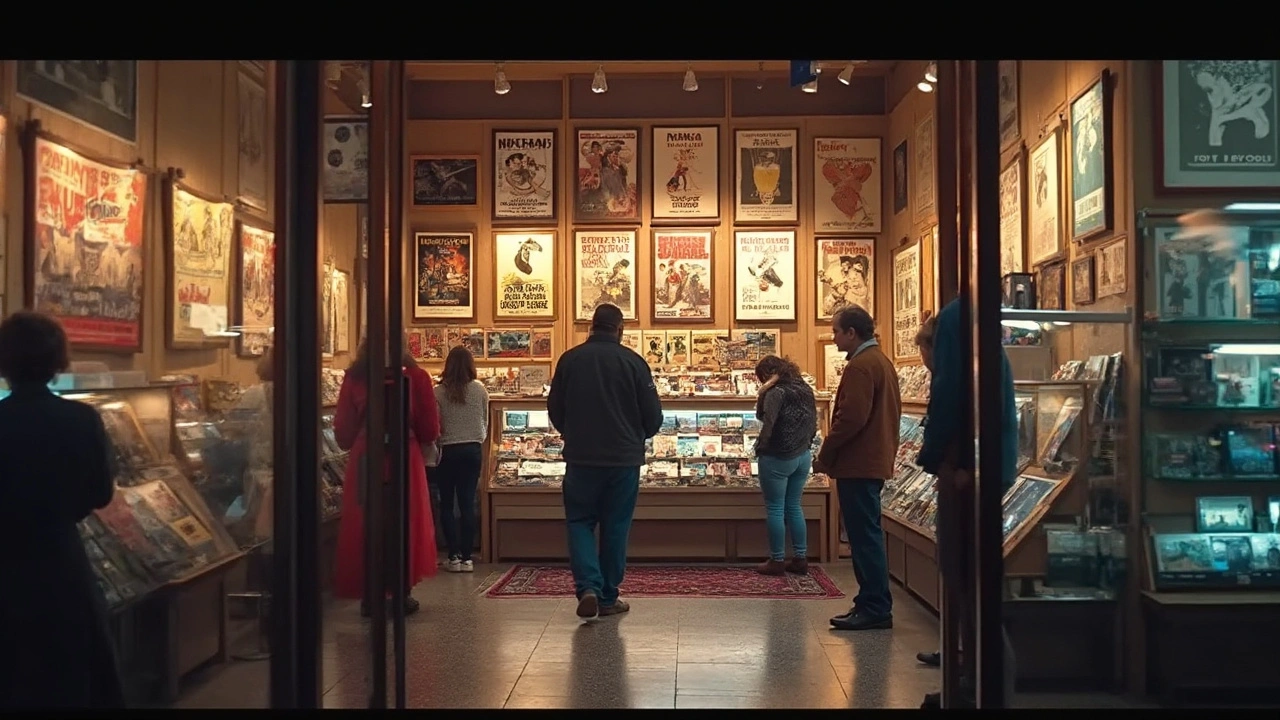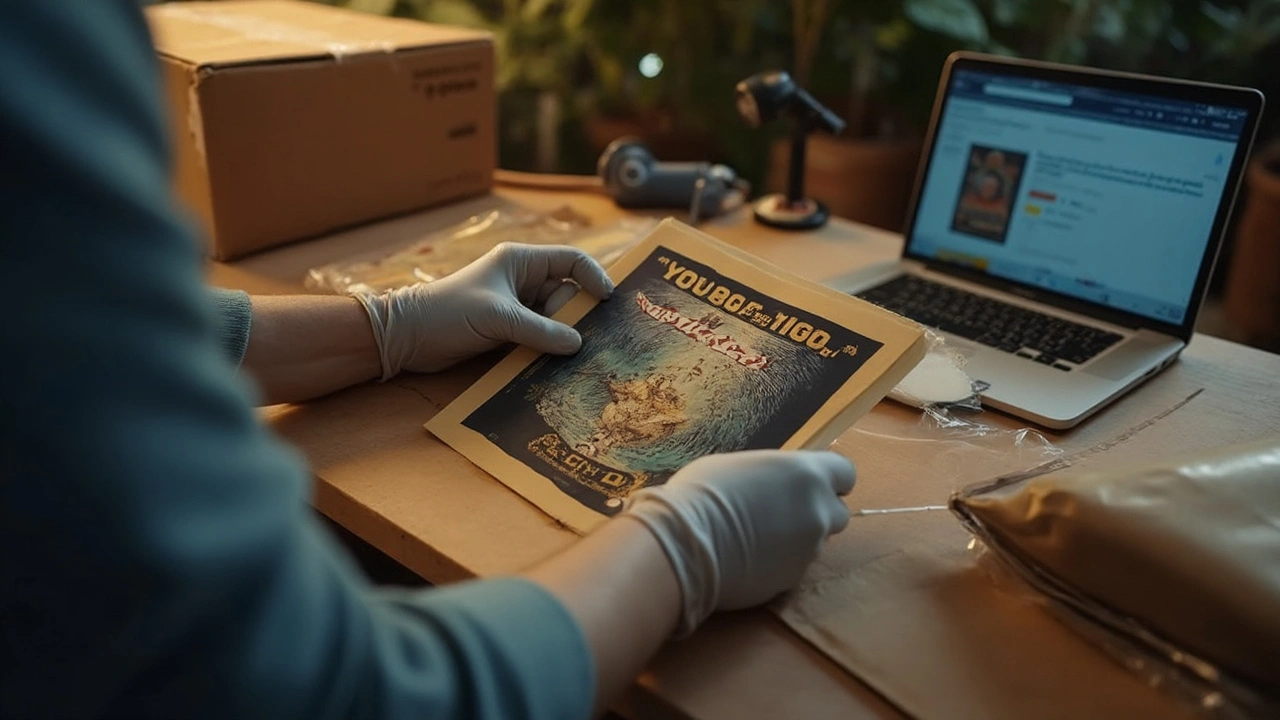If you think movie posters are mere wall fillers, you haven’t seen the look on a true collector’s face when you unwrap a rarity. Old posters aren’t just paper—they’re pop culture gold. In 2021, an original 1931 Frankenstein poster sold for almost $500,000 at auction. Selling movie posters is much more than a quick side hustle; it’s a scene full of passionate fans, meticulous grading, and a surprising web of online marketplaces. So, if you’ve unearthed a stack of posters in the attic or you’re thinking of flipping modern blockbusters for some extra cash, you’re probably wondering: where exactly should you sell movie posters to get the best deal and reach serious collectors?
Understanding the Movie Poster Market: More Than Just Nostalgia
Most folks start with the basics: you’ve got a pile of movie posters, maybe from your own youthful cinema trips or inherited from a relative who never missed a premiere. But before you rush to sell, let’s get a grip on what makes this niche so electric. It’s not nostalgia alone—collectors crave posters for many reasons: rare artwork, first-release printings, errors that slipped through quality control, and materials from foreign markets. Take, for example, the rise of international movie poster designs; Polish designers created genuinely surreal reinterpretations of Western films in the 1960s, and those are now collector magnets.
Then there are the materials and printing techniques. Vintage posters, especially pre-1980s, were usually printed on thinner paper and meant to be ephemeral—cinemas tossed them after the first run. That baked-in scarcity is why a 1941 "The Maltese Falcon" poster can command tens of thousands at auction even today. If you’re holding a newer poster, it’s likely printed in large numbers; the right buyer may still pay a premium if it’s a limited edition or features eye-catching alternate art. I once helped a friend sell a glow-in-the-dark "Tron: Legacy" print from Mondo—a wild Texas art collective—fetching triple the original price thanks to a hot run of demand among design junkies.
But here’s the rub: the poster market is fragmented. Some people only want original movie theater one-sheets; others obsess over international lobby cards or rereleases for cult classics. You have flippers, hardcore collectors, designers, and nostalgia fiends. Understanding your buyer is step one before diving into which site to use. If you’re lost figuring out exactly what you’ve got (first printing? reprint? hand-numbered artist edition?)—look at the fine print for studio marks, printer names, and dates. Posting a few ID photos on poster forums like the Stew or Reddit’s r/MoviePosters can get you quick feedback from people who’ve seen dozens just like yours. Don’t scrub away those old tape marks or try to "fix" edges before asking; sometimes, honest wear tells a story collectors value.
Rarity is only part of it. Demand can shift fast if a film enjoys a nostalgia bump from an anniversary rerelease or a star-studded reboot. When "Blade Runner 2049" hit screens, original 1982 "Blade Runner" posters surged in price—sometimes overnight. Trends are tricky, but if you time things right, a dull old print might become the next must-have. My wife, Evelyn, once convinced me to hold onto our "E.T." UK quad because Spielberg was teasing something new—and sure enough, the price moved up after a streaming anniversary special. The lesson? Sometimes waiting is smarter than selling in a hurry, but only if you keep your ear to the ground.
Grading matters more than people think. Mint, near-mint, good with edge wear—use clear, honest language. Professional grading isn’t always necessary for mainstream items, but for rare horror or sci-fi, buyers expect lots of details and crystal-clear photos. For massive wins, like a hard-to-find Tarantino teaser or a 1967 "The Graduate," consider getting a professional linen backing or archival restoration for added value, but check actual market prices first or you might pile up costs you can’t get back.

Battle of the Marketplaces: Where Real Collectors Hang Out
Now for the real nuts and bolts—where do you actually list your movie posters for sale? You’ve got more options than you might think, and each platform attracts its own kind of buyer. Let’s break down the big leagues and a few hidden gems.
eBay is still the 800-pound gorilla for selling everything from rare classics to mass-market studio one-sheets. The sheer number of eyes you’ll get is unbeatable, and with global shipping, you can snag buyers from every continent. Go ahead and search "vintage movie poster" and you’ll find everything from $5 Star Wars reprints to six-figure rarities. The catch? Everyone’s there—from bargain hunters to collectors to folks with zero clue about value. You have to sift through a ton of noise. Photos, detailed descriptions, and solid communication can help you float above the crowd. Don’t underestimate eBay’s Authenticity Guarantee program for high-value posters, which adds credibility (and sometimes bumps up bids).
Then there’s Heritage Auctions—the Ferrari of poster sales. At Heritage, you’re dealing with serious collectors and investors. This is where that $500,000 Frankenstein found a home. Their staff will walk you through every step, and their marketing gets your poster in front of people willing to pay premium prices. They vet consignments, so only the best or most interesting pieces make the cut. Fees are a bit higher, but many sellers believe it’s worth the exposure and expert handling.
If you’re looking for speed and simplicity, Facebook Marketplace has emerged as a surprisingly strong channel, especially for mid-range or modern posters. You’ll find local buyers who skip shipping headaches (and fees). It’s ideal if you don’t feel like dealing with postage tubes and insurance. Just be ready to answer a lot of "Is this still available?" messages. On that note, poster-focused Facebook Groups make a huge difference if you want advice, legit buyers, or even trades—look up "Movie Poster Buy/Sell/Trade" and jump in.
One site that’s become a household name among poster nerds is MoviePosterShop. They specialize in volume selling, offering a storefront-of-sorts for both originals and reproductions. If you’re moving lots of similar items, this is a no-brainer. The downside? Prices are typically a bit lower since it’s more like flipping stock than finding that “one perfect home” for your rare specimen.
eMoviePoster.com is tailor-made for true vintage and international collectors. They’re strict—only original promotional materials allowed—but with that comes credibility and a rabid audience. Their weekly auctions attract the right mix of hobbyists and hard-edged buyers, and the staff checks every submission for authenticity (no bootlegs here). You’ll want to carefully review their terms, as their grading standards are rigorous. Still, eMoviePoster’s focus on originals cuts through the junk and signals to buyers that your listing is the real deal.
There are also niche sites like Posteritati (which leans toward high-end, museum-quality pieces), Justin Ishmael (great for cult and artist prints), and even Etsy for custom, reimagined, or vintage poster sales. Etsy is brilliant if you have a mix of old and new, or you’re selling hand-numbered prints from small studios. Buyers seeking Mondo and Bottleneck Gallery releases flock here. You can even tap into art communities like DeviantArt or Behance if your posters are more design-forward, but be ready to do more legwork to reach film buffs.
If you’re after international exposure, Catawiki (popular in Europe) has carved out a space for rare posters, especially for non-US films. They have expert curators, and their weekly themed auctions can put your piece in front of serious buyers abroad. Fee structures differ from place to place, so always check the numbers before diving in.
Quick tip: If you’re stuck between platforms, look for recent sales of posters just like yours. Sites like WorthPoint and Heritage’s past auction archives are treasure troves for pricing. If you see an obvious trend—like "Jaws" originals spiking around Shark Week—adjust your listings and timing.
Some treasure their posters so much, they’ll buy directly from you if you fish around specific online forums. The poster collecting world is weirdly personal; I’ve met fellow collectors in places as random as Reddit threads or old-school discussion boards like AllPostersFan. Every sale starts with a conversation, and once you become known in these circles, folks will seek you out for trades, offers, or even long-term relationships. If you only have one or two posters to move, these spaces might be a little too slow or insular, but for larger collections or rare finds, they’re goldmines.
Watch out for counterfeits, especially with blockbusters. Bootleg or fan-printed posters flood the market, particularly for Star Wars and Marvel. Legitimate sites check for authenticity and warn buyers, but if you’re on unsupervised marketplaces, buyers may grill you for extra photos, studio stamps, or provenance. Save your receipts or show a photo of the original cinema holding it—just something to build trust. Nothing torpedoes a sale faster than sketchy photos or evasive answers about the poster’s origin.

Selling Smarter: Tips, Tricks, and Shipping Without Nightmares
Selling isn’t just about picking the right site; how you present, price, and deliver your poster seals the deal. For starters, clean, high-resolution photos are everything. Snap multiple angles—front, back, close-up of credits, edges, any flaws or creases. Hold your phone parallel to the poster to avoid distortion, and pull back far enough so collectors can see the whole image and details (logistics nerd tip: use painter’s tape to lightly hold edges flat). Adding a ruler or standard-sized object helps buyers judge size and proportion.
When writing up your listing, avoid buzzwords and stick to facts. Instead of "awesome condition," try "original 1978 Star Wars one-sheet, first-run NSS mark, minimal edge wear, small crease top right." If possible, link to previous sales or include a screenshot of a similar auction result. Nothing establishes confidence like proof someone has paid real money for a nearly identical poster. State clearly whether it’s rolled, folded, or flat-packed—the difference can mean hundreds of dollars to the right collector.
Pricing is tricky. If the same poster has recently sold for wildly different amounts, don’t just shoot for the middle; add your own spin. If the copy you’re selling is cleaner, signed, or comes with an interesting backstory (maybe you got it from a cast member at a festival—hey, Evelyn was once handed a "Lost in Translation" mini-poster by Bill Murray at TIFF), let folks know. If shipping is pricy where you are, consider baking the cost into the price and offering "free shipping"—it’s more attractive and feels like a better deal to buyers scanning dozens of similar listings.
Let’s talk shipping. Rolled posters should go in sturdy tubes (never a triangle mailer), with craft paper to buffer the art. Folded posters, especially vintage, need flat-pack shipping between heavy cardboard sheets. Always use acid-free materials if it’s anything rare. Mark packages as "Do Not Bend" and insure for the full declared value. Photograph everything before packing—you’d be surprised how often this saves lost sales and PayPal disputes. Buyers are jumpy about damage, and you want every angle covered.
- Insure high-value posters. Even seasoned sellers get burned by postal accidents. Don’t cut corners on rare items; that extra $20 or so could be a lifesaver.
- Double-check import rules if selling internationally. Some countries will slap massive fees or deny posters they believe are “cultural artifacts.” Always check before finalizing the deal.
- Stay communicative. Buyers love updates—photos of packing, tracking numbers, and email check-ins make you memorable, and keep nerves at bay.
- Bundle sales for repeat buyers. If one customer loves your style or collection, offer a discount for multiple purchases. Word spreads fast in the collector community, and you might turn a one-off deal into a steady gig.
Give special attention to authenticity and provenance, especially for anything from the golden age of Hollywood or cult classics. If you’re not sure about something, ask in collector groups or send scans to a professional. And always price with intent; don’t get greedy if you see ten listings with the same poster priced absurdly high and none have sold in a year. Stick with real sales, communicate honestly, and treat buyers as fellow movie fans, not marks to be fleeced.
The world of selling movie posters is way deeper than most folks expect. Pick the right buyer by choosing the right platform. If you’re just flipping a Stranger Things season one-sheet, aim for eBay or Facebook. But if you have something rare, quirky, or drenched in history, push for specialist auctions or reach into the deepest outposts of collector communities. Who knows—maybe you’ll meet a fellow movie nut like Evelyn and me, hunting together for the next big screen treasure to frame above the couch.



Comments
Alright, who else has tried selling movie posters online and ended up wondering if they accidentally opened a shop in a ghost town?
Honestly, I'm curious about which sites really get collectors drooling and not just lurking. I mean, eBay is classic, but is it the end-all? What about those niche marketplaces with supposed high rollers?
Also, shipping horror stories incoming? You'd think just rolling a poster and tossing it in a tube would cut it, but nah, we gotta treat these like newborn babies.
Anyone got hot tips on how to price without sounding like you're auctioning the Mona Lisa or just giving a garage sale vibe?
Let's get this poster party started, I need some inspiration before I drown in my stash.
Oh, I totally get where you're coming from! Pricing feels like navigating a minefield.
I've learned over time that doing a quick detective work on recently sold similar posters on various sites helps a lot. Mostly on eBay though.
I found that larger marketplaces provide better visibility, but the niche sites attract serious collectors willing to pay a premium for rare finds.
Also, make sure your listing photos are top-notch – blurry or badly lit images kill any chance of a serious offer.
On shipping, padded tubes with extra tape and internal 'wriggle room' save you from tears (yours and the buyer's!).
Anyone else noticed how some collectors prefer local pickups to avoid shipping risks?
Oh hey, good point about local pickups. I’ve had a couple folk come round in the past, and it’s honestly a lifesaver when shipping costs skyrocket.
That said, I usually ship. I wrap mine in bubble wrap and add extra cardboard layers. It feels like sending a fragile egg every time but worth it for the peace of mind.
Also, I kinda agree on the photos – sometimes people miss that it’s about showcasing the poster’s condition clearly, not just a quick snap.
Prices tho? I’ve had some success just setting slightly under marketplace average to get a quicker sale.
Although, I wouldn’t drop price too low unless you’re desperate; collectors tend to respect fair pricing.
Just putting my two cents in, I actually think sometimes the enthusiast niche sites have a better vibe for collectors. Big marketplaces feel like chaos to me.
That’s not to say big sites don’t work – they reach more eyeballs, sure. But you might get a few casual buyers, not the ones with serious wallets.
Plus, the community on some dedicated poster forums and marketplaces genuinely share knowledge and tips, which helps you refine your listings and prices.
There’s also the social factor—sometimes you connect with buyers and collectors who turn into regulars if you’re trustworthy and responsive.
Anyone else a fan of community-driven selling over the big commercial hubs?
Indeed, the intersection of high art and commerce presents unique challenges.
The market for movie posters is a delicate ecosystem where the provenance and condition elevate mere paper to collectible treasure.
One must consider how aesthetic appeal and rarity influence pricing drastically beyond mere marketplace logistics.
Furthermore, engaging in specialized auctions or collaborating with established collectors can sometimes yield significantly higher returns than impersonal online transactions.
For those serious about poster selling, elevating your approach beyond the pedestrian is essentially requisite.
Has anyone explored boutique auction houses for their sales?
Uff this market is a damn nightmare sometimes. Everyone and their grandma think their poster from a thrift shop is worth a million bucks.
Selling online looks easy but you end up wasting days on messaging flakers and browsers only looking for freebies.
Shipping? Most sellers don't even realize how much a tube costs on international mail. You gotta price in that pain or you're losing money.
Also, I swear 90% of collectors are drama queens about poster folds and tiny creases.
Sometimes I just wanna scream: it's a poster, chill.
Can we PLEASE talk about the grammatical horrors in some listings? "Minting condition"? It's MINT, not minting.
Also, spell check is your friend. Misleading or sloppy descriptions can seriously hurt your sale chance.
I always ensure to describe any damage precisely and use proper terminology.
It's amazing how tightening your language makes sellers appear so much more professional and trustworthy.
How many of you meticulously proofread your listings or have someone else do it before posting?
Okay, not to stir the pot, but I find some sellers ridiculously dramatic about the 'condition issues' like it's the end of the world if there's a corner dip.
Like, hello? It's a freaking poster, not the Declaration of Independence!
I guess some collectors want perfection, but honestly, I think a bit of character adds charm and maybe even value.
However, I do agree that transparency is key, but the over-the-top meltdowns over minor flaws are exhausting.
So yeah, sellers, keep it real but don’t cry rivers over every tiny crease.
Look, I honestly think some big sites are rigged to favor professional sellers and suppress small folks trying to make a quick buck.
Ever noticed how some listings mysteriously get more views or get pushed higher? It makes you wonder if there's an unfair algorithm or paid priority going on.
This is why I always prefer direct or community-driven sales to avoid that nonsense.
Plus, I think some collectors are in on it too, driving prices up artificially and reselling.
Anyone else feels like this market is kinda shady beneath the shiny surface?
Not to jump on the conspiracy train but I see the point about the algorithms. Yet, I feel communities where sellers and buyers interact openly do keep things more honest.
I have had good luck selling smaller prints in local groups before trying bigger sites.
Sometimes it’s just about finding your niche and audience, whether local or global.
Don’t let the internet’s vastness intimidate you; a focused market works wonders.